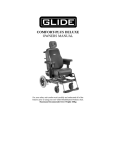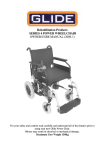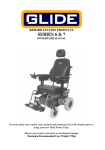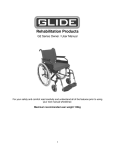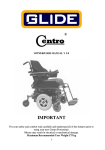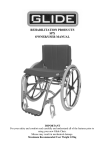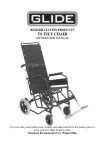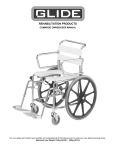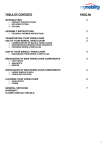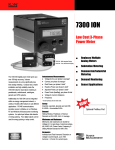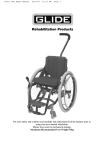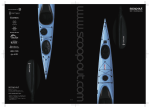Download G1 G3 Series owners manual - Glide Rehabilitation Products
Transcript
99516 OWNER MANUAL G1-G3 22/7/05 02:58 PM Page 1 G1 & G3 SERIES OWNER/USER MANUAL FOR YOUR SAFETY AND COMFORT READ CAREFULLY AND UNDERSTAND ALL OF THE FEATURES PRIOR TO USING YOUR NEW MANUAL WHEELCHAIR Maximum recommended user weight 100kg 99516 OWNER MANUAL G1-G3 22/7/05 02:58 PM Page 2 TABLE OF CONTENTS SECTION DESCRIPTION SECTION DESCRIPTION PAGE 1 INTRODUCTION 1 10 CROSS BRACE 9 2 GETTING ACQUAINTED WITH YOUR CHAIR 2 11 TYRES/CASTOR TYRES 9 BACKREST AND SEAT UPHOLSTERY 12 OPERATION OF THE WHEELCHAIR 12 3 13 TRANSPORTING YOUR CHAIR 13 4 ARMREST 4 14 OPTIONS 14 5 FOOTPLATES 5 15 SERVICING 15 6 FORKS AND CASTORS 6 16 WARRANTY 16 - 17 7 BRAKES 7 8 WHEELS 8 9 OPENING AND FOLDING THE WHEELCHAIR 9 3 PAGE 99516 OWNER MANUAL G1-G3 22/7/05 02:58 PM Page 3 SECTION 1 1 INTRODUCTION Thank you for choosing the Glide G1/G3 Manual Wheelchair. An Australian designed and manufactured product which complies with AS 3695 and EN 12183 Standards (Type B classification) and has a manufacturers recommended user weight of 100kg for standard G1 and G3. 180kg recommended maximum user weight for Heavy Duty G3 wheelchair. With proper care and operation, your G1/G3 chair will provide years of trouble free use. Please take the time familiarise yourself with the functions and features of your chair by reading this owner/user manual. If you have any queries about the functions of the chair you can call Glide Rehabilitation Products or your nearest Glide Rehabilitation Products dealer. Glide Rehabilitation Products +61 8 9345 3400 99516 OWNER MANUAL G1-G3 22/7/05 02:58 PM Page 4 SECTION 2 GETTING ACQUAINTED WITH YOUR MANUAL WHEELCHAIR 2 99516 OWNER MANUAL G1-G3 22/7/05 02:58 PM Page 5 SECTION 3 UPHOLSTERY With proper care your upholstery should give years of trouble free service. It is very important to read the following: • Regular (weekly) cleaning of back and seat upholstery is very important to remove body oils which can cause hardening of the vinyl. To clean, wipe with a cloth or sponge, which has been moistened in warm soapy water, and then dry with a soft, clean cloth. The use of mild non-abrasive pure soap is recommended. Stubborn grime may require gentle scrubbing with a soft brush. Warning • Never use furniture polishes, abrasive cleaners or steel wool. Regular use of cleaners containing hydrocarbons or similar additives may cause damage to the vinyl and harden the surface. • Always replace broken upholstery screws immediately to avoid possible tearing. • Stretched, torn or split upholstery must be replaced for safety reasons. 3 99516 OWNER MANUAL G1-G3 22/7/05 02:58 PM SECTION 4 ARMREST To remove: • Push button and hold in on front arm socket. • Using other hand lift armrest upwards. Note: Wheelchairs may be supplied without button locks. To install: • Replace armrest into front and rear arm sockets, push button in and armrest down simultaneously. • Ensure armrest is secure and button has popped out. Warning • Never lift wheelchair by armrest as damage may occur. 4 Page 6 99516 OWNER MANUAL G1-G3 22/7/05 02:58 PM Page 7 SECTION 5 FOOTREST To remove: • Push lever inwards to unlock and swing outwards. • Lift upwards to remove. To install • Insert footrest back on the two locating pins and swing inwards for automatic locking. To adjust footplates • Remove hexagonal bolt. • Move up or down. Line up the nearest hole for the desired height. • Replace hexagonal bolt and tighten. Warning • The footrests are designed to support the weight of the leg only. Never stand on footplates. 5 99516 OWNER MANUAL G1-G3 22/7/05 02:58 PM SECTION 6 FORKS AND CASTORS Assembly • Press bearing housing into bottom of castor tube. • Press castor bush into top of castor tube. • Slide castor pintle through bearing housing the castor bush. • Place circlip on castor pintle. • Slide bearing on pintle and locate in bearing housing. • Screw hex-nut until there is 1mm of up and down pintle movement. • Place castor fork in position and tighten locknut. Important Once tightened ensure 1mm of up and down movement and castor turns freely. 6 Page 8 99516 OWNER MANUAL G1-G3 22/7/05 02:58 PM Page 9 SECTION 7 BRAKES • Brakes are designed as a locking device only and should be applied when the wheelchair is stationary. Do not use brakes for slowing the wheelchair. Use the push rims as a means of braking. Adjusting Brakes • Inflate tyre to correct pressure before making adjustment to brakes. • Loosen locking screws, using 5mm Allen key, on brake clamp and adjust brake so when the lever is in the locked position the wheel is firmly held. • Re-tighten locking screws using 5mm Allen key. • Check that, when both brakes are applied, the wheelchair will not roll. If rolling occurs re-adjust. • When brakes are in the off position the bars should not rub against the tyre 7 99516 OWNER MANUAL G1-G3 22/7/05 02:58 PM Page 10 SECTION 8 The large wheels are fitted with sealed ball bearings and should last many years without replacement. Large Wheels (fixed) • To remove large wheels unscrew locknut and using a large screwdriver unscrew axle and remove when free. • Installation is the reverse procedure. Large Wheels (quick release) • To remove large wheels (quick release) push button in and slide wheel out while button is still pushed in. • To install push button in and slide wheel in. • Wheels should be removed weekly and axles and sockets wiped clean with a soft cloth to avoid jamming in socket. Smear axle with dri-lube stick before replacing. Warning • Do not use wheelchair, unless button is fully out when wheels are in place. 8 99516 OWNER MANUAL G1-G3 22/7/05 02:58 PM Page 11 SECTION 9 SECTION 11 FOLDING AND OPENING THE WHEELCHAIR TYRES/CASTOR TYRES Opening • Take a position at one side of the wheelchair, and then tilt the wheelchair towards you until the wheels are off the ground on the opposite side. • Press down in the centre of the upholstery bar nearest you. • Worn and under inflated tyres will render the wheelchair difficult to steer and propel. Large wheel tyres and castor tyres should only be replaced as pairs. • Tyre pressure for rear wheels 380kpa (55psi) Folding • Before folding flip footplates to the up position. • Grasp the seat upholstery front and rear approximately centre and lift upwards. • SECTION 10 CROSSBRACE • ANTI-TIP WHEELS The cross brace centre bolt must slide back and forwards 5mm to 10mm. This free play enables the 4 wheels to be in contact with the ground. 9 When anti-tip wheels are required, please contact your nearest Glide Rehabilitation Products dealer for correct fitting procedures. WARNING - interference with kerbs may occur when anti-tip wheels are fitted. 99516 OWNER MANUAL G1-G3 22/7/05 02:58 PM Page 12 SECTION 12 OPERATION OF WHEELCHAIR Dynamic stability Using the wheelchair in difficult situations such as steep downgrades, upgrades, side cambered pathways and obstacles may be hazardous. The following methods should be used to avoid tipping. When climbing a gradient, the stability of the wheelchair can be improved greatly by leaning the body forward. On downgrades, the body should be in a straight position and the speed and direction of the wheelchair controlled by the push rims (not brakes). Under normal conditions (clean dry surface with no side camber) it is possible to climb slopes safely of up to 13 degrees. Note G1 - Maximum safe slope 13 degrees. G3 - Maximum safe slope 10 degrees. 10 99516 OWNER MANUAL G1-G3 22/7/05 02:58 PM Page 13 SECTION 12 - 1 OPERATION OF WHEELCHAIR Crossing obstacles If you are a first time user or don’t have the physical strength, it is advisable to have an attendant assist you while crossing obstacles (e.g. sidewalk kerb). The attendant can tilt the chair back using the hand grips and the rear tilt bar, then pushing large wheels as far as the kerb, then lifting the wheelchair up over the kerb. If you are an experienced user and have the physical strength, the following method may be used. Place the wheelchair in front of the kerb. By moving the push rim quickly forward, the castors will lift and the chair will surge forward enabling you to place the castors on top of the kerb. Then by leaning forward ease the rear wheels up the kerb. If footplate touches obstacle, perform same operation but lift the front castor just before the obstacle is reached. 11 99516 OWNER MANUAL G1-G3 22/7/05 02:58 PM Page 14 SECTION 12 - 2 OPERATION OF WHEELCHAIR Descending from obstacle: Descending from shallow obstacles can be dealt with by rolling forward and keeping the body in an upright position. Higher obstacles can be dealt with by reversing. Bring the two large wheels to the edge of the obstacle and slowing easing down using the push rim as a brake and the body leaning forwards to avoid tipping. Static ability Reaching forward, to the side or to the back of the wheelchair will affect the stability of the wheelchair. Do not take risks, especially when chair is not on a level plane. Seat belt If there is a need for a lap type posture restraining belt to be fitted to the G1/G3 Wheelchair Chair we recommend that you contact your nearest agent or Glide Rehabilitation Products direct for correct fitting procedures. 12 99516 OWNER MANUAL G1-G3 22/7/05 02:58 PM Page 15 SECTION 13 TRANSPORTING YOUR CHAIR Glide Products is not in a position to recommend the type of tie-down restraint system for transportation of a person while in a wheelchair, however we have determined tie down locations for the G1/G3 chair when being transported. Recommendation and information regarding vehicle restraint systems, for use while a person is in a wheelchair, should be sourced from your health professional or local Department of Transport. Where possible wheelchair occupants should be transferred into and use the proper vehicle seat and restraints as supplied by the automotive industry. NOTE: Ensure that your restraint system complies with AS2942 and you fully understand the manufacturer instructions on how your tie down system works and whether it is compatible with the Glide Rehabilitation Products chair. 13 99516 OWNER MANUAL G1-G3 22/7/05 02:58 PM Page 16 SECTION 14 OPTIONS Listed below are some of the common options available. Options can be supplied in lieu of parts when ordering a new wheelchair or sold as a spare part at a later date. • • • • • • • • • • • • • • • • • • • • • Elevating leg rests Tray Crutch holder Quick release hubs Arm trough Desk arms Adjustable height arms Heel loops Pneumatic castors Thorn resistant tubes (large wheel) Spoke guards 14 Anti tip bars Oxygen bottle carrier Brake extension Lambs wool covers I.V. poles Head rest extension Stump support Wide castors Solid castors Seat belt 99516 OWNER MANUAL G1-G3 22/7/05 02:58 PM Page 17 SECTION 15 SERVICING Weekly • Cleaning and care of upholstery as described in (section 3). • Check the pressure and condition of tyres. Do not exceed maximum pressure advised on side of tyre. • Service quick release axle if applicable (section 8). Every 3 months • Check castor play (section 6). • Check brakes and adjust if necessary (section 7). • Ensure that all nuts and screws are tight. • Check rear wheels for loose spokes. Spokes should be tightened by an experienced wheel builder. • Regular cleaning will restore your wheelchair to its original finish. Every year • We advise that your wheelchair be serviced by an approved dealer at least once a year. This will ensure that your wheelchair is in a safe operating condition. 15 99516 OWNER MANUAL G1-G3 22/7/05 02:58 PM Page 18 SECTION 16 WARRANTY Lendal Pty Ltd (trading as Glide Rehabilitation Products) warrants all manufactured and distributed products against defects in materials and workmanship for a period of one year from purchase date. Lendal Pty Ltd will repair or replace any part, as required, provided the purchased product is delivered intact and prepaid to a location authorised by Lendal Pty Ltd within the prescribed period of warranty. This warranty does not extend to parts damaged by misuse, neglect, accident or improper installation, nor those tampered with, altered or serviced by an agency not authorised by Lendal Pty Ltd. The foregoing in lieu of all other warranties expressed, implied or statutory. Lendal Pty Ltd’s sole liability shall be to repair parts of components as specified above. 16 99516 OWNER MANUAL G1-G3 22/7/05 02:58 PM Page 19 SECTION 16-1 WARRANTY The following details will be required when making a warranty claim. Make sure all the relevant details are filled in at time of purchase. Name Address City Purchased by (e.g. Hospital) Serial No. Purchase Date Series/Model No. Size Dealers Name 17 99516 OWNER MANUAL G1-G3 22/7/05 02:58 PM Page 20 APPLY BRAKES WHEN TRANSFERRING PATIENTS READ THE OPERATOR & INSTRUCTION MANUAL Glide Rehabilitation Products are manufactured in Australia by Lendal Pty. Ltd. (ACN 009 033 694) 25 Ledgar Road, Balcatta, Western Australia 6021 Phone: +61 8 9345 3400 Fax: +61 8 9345 1318 Email: [email protected] Web: www.glide.com.au ABN 60 157 412 811 A WHOLLY OWNED AUSTRALIAN COMPANY




















